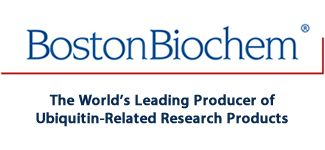
Recombinant Human SUMO3 Mutant K11R Protein, CF Summary
Product Datasheets
Carrier Free
CF stands for Carrier Free (CF). We typically add Bovine Serum Albumin (BSA) as a carrier protein to our recombinant proteins.Adding a carrier protein enhances protein stability, increases shelf-life, and allows the recombinant protein to be stored at a more dilute concentration.The carrier free version does not contain BSA.
In general, we advise purchasing the recombinant protein with BSA for use in cell or tissue culture, or as an ELISA standard.In contrast, the carrier free protein is recommended for applications, in which the presence of BSA could interfere.
ULM-762
| Formulation | Supplied as a solution of HEPES, NaCl and DTT |
| Shipping | The product is shipped with dry ice or equivalent. Upon receipt, store it immediately at the temperature recommended below. |
| Stability & Storage: | Use a manual defrost freezer and avoid repeated freeze-thaw cycles.
|
Reconstitution Calculator
Background: SUMO3
Human Small Ubiquitin-like Modifier 3 (SUMO3), also known as SMT3A, is synthesized as a 103 amino acid (aa), propeptide with a predicted 11.5 kDa. SUMO3 contains a two aa C-terminal prosegment. Human SUMO3 shares 83% sequence identity with mouse SUMO3. SUMO3 also has high aa sequence homology to SUMO2 and SUMO4, 87% and 75%, respectively. SUMO3 shares only 47% sequence identity with SUMO1. SUMOs are a family of small, related proteins that can be enzymatically attached to a target protein by a post-translational modification process termed SUMOylation (1-3). All SUMO proteins share a conserved Ubiquitin domain and a C-terminal diglycine cleavage/attachment site. Following prosegment cleavage, the C-terminal glycine residue of SUMO3 is enzymatically attached to a lysine residue on a target protein. In humans, SUMO3 is conjugated to a variety of molecules in the presence of the SAE1/UBA2 SUMO-activating (E1) enzyme and the UBE2I/Ubc9 SUMO-conjugating (E2) enzyme (4,5). In yeast, the SUMO-activating (E1) enzyme is Aos1/Uba2p (6). Because of the high level of sequence homology most studies report effects of SUMO2/3. For example, addition of SUMO2/3 was shown to modulate the function of ARHGAP21, a RhoGAP protein known to be involved in cell migration (7). Other reports indicate that the conjugation by SUMO2/3, but not SUMO1, may represent an important mechanism to protect neurons during episodes of cerebral ischemia (8,9). However, studies suggest that SUMO2/3 expression is regulated in an isoform-specific manner since oxidative stress downregulated the transcription of SUMO3 but not SUMO2 (10).
Mutation of lysine 11 to arginine renders SUMO-3 unable to form poly-SUMO multimers and is useful to investigate mono-SUMOylation or can be used to reduce poly-SUMO chain formation. Human SUMO-3 contains the VK11TE sequence which allows for the formation of poly-SUMO chains. K11 is the conserved lysine that becomes modified and is the point of attachment for the C-terminal glycine of the preceding SUMO-3. The function of SUMO chains has not yet been fully elucidated.
- Desterro, J.M. et al. (1997) FEBs. Lett. 417:297.
- Bettermann, K. et al. (2012) Cancer Lett. 316:113.
- Praefcke, G.J. et al. (2012) Trends Biochem. Sci. 37:23.
- Okuma, T. et al. (1999) Biochem. Biophys. Res.Commun. 254:693.
- Tatham, M.H. et al. (2001) J. Biol. Chem. 276:35368.
- Johnson, E.S. et al. (1997) EMBO J. 16:5509.
- Bigarella, C.L. et al. (2012) FEBS Lett. 586:3522.
- Datwyler, A.L. et al. (2012) J. Cereb. Blood Flow Metab. 31:2152.
- Wang, Z. et al. (2012) Protein Expr. Purif. 82:174.
- Sang, J. et al. (2012) Biochem. J. 435:489.
FAQs
No product specific FAQs exist for this product, however you may
View all Proteins and Enzyme FAQsAffinity Matrices
Recombinant Human HR23A Tandem UBA (TUBE1) Agarose, CF
Recombinant Enzymes
Recombinant Human UBE2I/Ubc9 Protein, CF
Recombinant Human SUMO E1 (SAE1/UBA2) Protein, CF
Recombinant Proteins
Recombinant Human SUMO1 AMC Protein, CF
Recombinant Human SUMO2 Protein, CF
Recombinant Human Ubiquitin Protein, CF
Reviews for Recombinant Human SUMO3 Mutant K11R Protein, CF
There are currently no reviews for this product. Be the first toreview Recombinant Human SUMO3 Mutant K11R Protein, CF and earn rewards!
Have you used Recombinant Human SUMO3 Mutant K11R Protein, CF?
Submit a review and receive an Amazon gift card.
$25/€18/£15/$25CAN/¥75 Yuan/¥1250 Yen for a review with an image
$10/€7/£6/$10 CAD/¥70 Yuan/¥1110 Yen for a review without an image
ebiomall.com






>
>
>
>
>
>
>
>
>
>
>
>
可分为以下几个类群:(1)依赖DNA的DNA聚合酶;(2)依赖RNA的DNA聚合酶;(3)依赖DNA的RNA聚合酶;(4)依赖RNA的RNA聚合酶。前两者是DNA聚合酶,它使DNA复制链按模板顺序延长。如在原核生物中仅就大肠杆菌中已被发现的就有三种(分别简称为PolⅠ,PolⅡ和PolⅢ等);DNA聚合酶只能在有引物的基础上,即在DNA或RNA引物的3′-OH延伸,这DNA的合成方向记为5′→3′。换言之DNA聚合酶催化反应除底物(αNTP)外,还需要Mg2+ 、模板DNA和引物,迄今细胞内尚无发现可从单体起始DNA的合成。同样,上述(3)和(4)是催化RNA生物合成反应中最主要的RNA合成酶,它们以四种三磷酸核糖核苷(NTP)为底物,并需有DNA模板以及Mn2 及Mg2 的存在下,在前一个核苷酸3′-OH与下一个核苷酸的5′-P聚合形成3′,5′-磷酸二酯键,其新生链的方向也是5′→3′。RNA聚合酶也大量存在于原核和真核生物的细胞中。如大肠杆菌RNA聚合酶分子量4.8×105,由5条多肽链组成,分别命名为α,α,β,β′,和γ,全酶可用α2ββ′λ表示。真核生物RNA聚合酶分子大于5×105,由10~12个大小不等亚基组成。聚合酶除作为自然界生命活动中不可缺少的组分外,在实验室中大多用作生命科学研究的工具酶类之一。
但是也有以RNA为模板的DNA聚合酶和RNA聚合酶 (也就是反转录酶和RNA依赖的RNA聚合酶),它们的结合位点在RNA上.
也就是说,模版是谁,结合位点就在谁上。
2.结合位点就是启动合成DNA或者RNA的碱基序列,如RNA聚合酶结合位点是转录起始位点,是一段特殊的位于编码基因上游的DNA序列.这段DNA序列可以结合RNA聚合酶,从而起始转录过程.经典的RNA聚合酶结合位点是TATA box.
TATA box是编码序列前的4个碱基.在大多数生物的基因前面都有TATA着4个碱基序列的存在,它就是一个RNA聚合酶结合位点.
可分为以下几个类群:(1)依赖DNA的DNA聚合酶;(2)依赖RNA的DNA聚合酶;(3)依赖DNA的RNA聚合酶;(4)依赖RNA的RNA聚合酶。前两者是DNA聚合酶,它使DNA复制链按模板顺序延长。如在原核生物中仅就大肠杆菌中已被发现的就有三种(分别简称为PolⅠ,PolⅡ和PolⅢ等);DNA聚合酶只能在有引物的基础上,即在DNA或RNA引物的3′-OH延伸,这DNA的合成方向记为5′→3′。换言之DNA聚合酶催化反应除底物(αNTP)外,还需要Mg2+ 、模板DNA和引物,迄今细胞内尚无发现可从单体起始DNA的合成。同样,上述(3)和(4)是催化RNA生物合成反应中最主要的RNA合成酶,它们以四种三磷酸核糖核苷(NTP)为底物,并需有DNA模板以及Mn2 及Mg2 的存在下,在前一个核苷酸3′-OH与下一个核苷酸的5′-P聚合形成3′,5′-磷酸二酯键,其新生链的方向也是5′→3′。RNA聚合酶也大量存在于原核和真核生物的细胞中。如大肠杆菌RNA聚合酶分子量4.8×105,由5条多肽链组成,分别命名为α,α,β,β′,和γ,全酶可用α2ββ′λ表示。真核生物RNA聚合酶分子大于5×105,由10~12个大小不等亚基组成。聚合酶除作为自然界生命活动中不可缺少的组分外,在实验室中大多用作生命科学研究的工具酶类之一。向左转|向右转
不同点:
1、作用底物不同。RNA聚合酶底物是NTP;DNA聚合酶底物是dNTP。
2、RNA聚合酶作用不需要引物,而DNA聚合酶作用需要引物。
3、RNA聚合酶本身具有一定的解旋功能,而DNA聚合酶没有,当需要解开双链的时候要解旋酶和拓扑异构酶的帮助。
4、RNA聚合酶只具有5‘到3’端的聚合酶活性,而DNA聚合酶不仅有5‘到3’端的聚合酶活性,还具有3‘到5’端的外切酶活性。保证DNA复制时候校对,所以复制的忠实性高于转录的。
5、RNA聚合酶通常作用于转录过程;DNA聚合酶通常作用于DNA复制过程。
再来说真核生物,真核生物的DNA聚合酶分为α,β,γ,δ,ε,.首先我来说三个和原核生物中的Ⅰ,Ⅱ,Ⅲ功能相同的酶.ε类似于原核生物DNA聚合酶Ⅰ,β类似于原核生物DNA聚合酶Ⅱ,δ类似于原核生物DNA聚合酶Ⅲ.α具有引物酶活性,而γ则是作为复制真核生物线粒体内的DNA所需要的酶.









